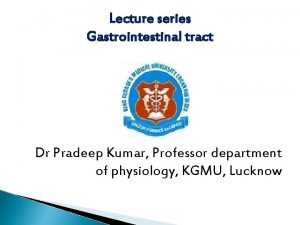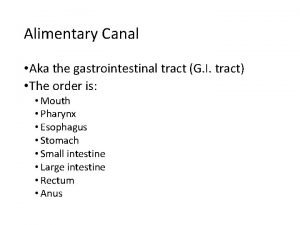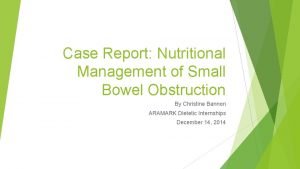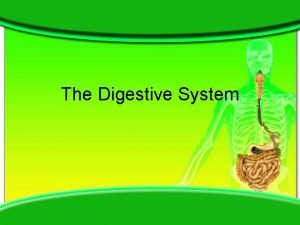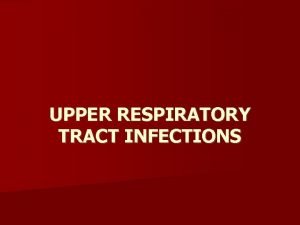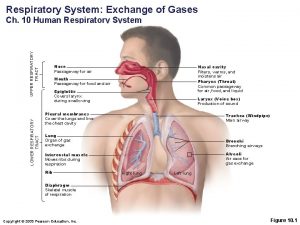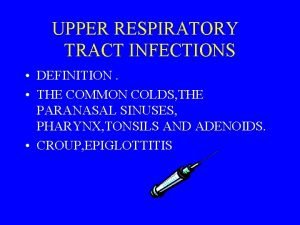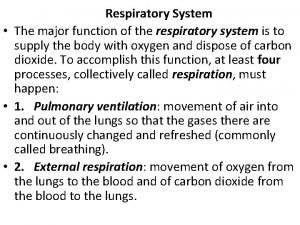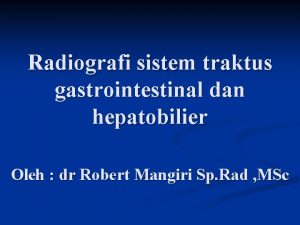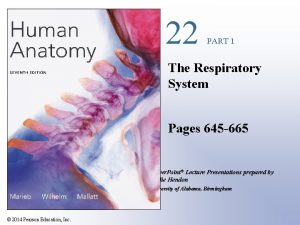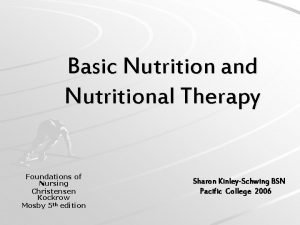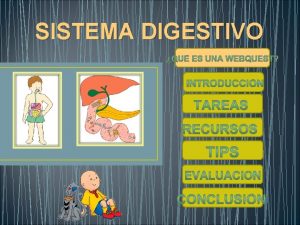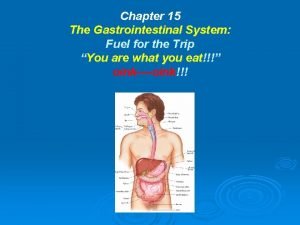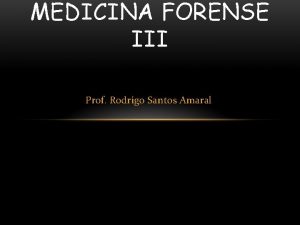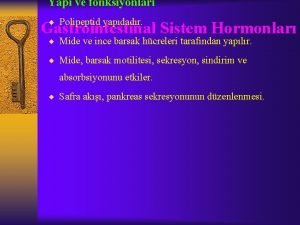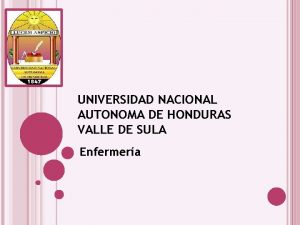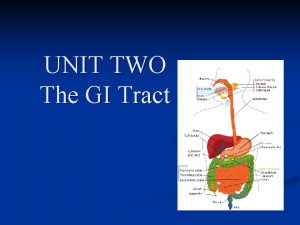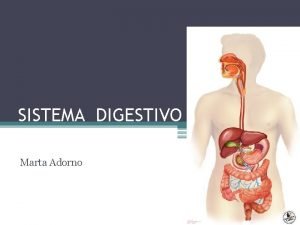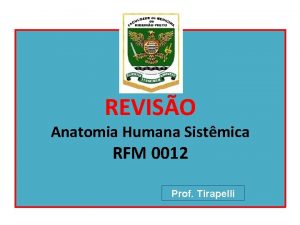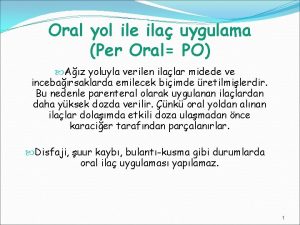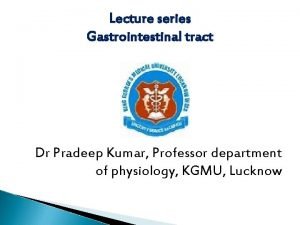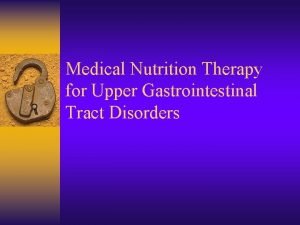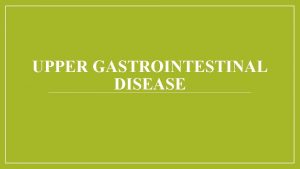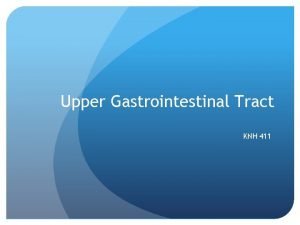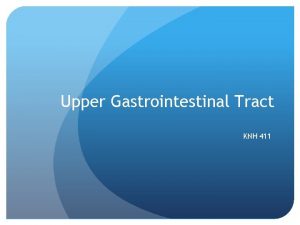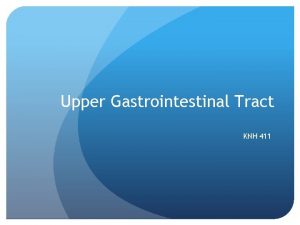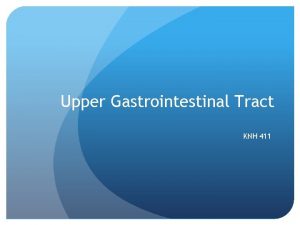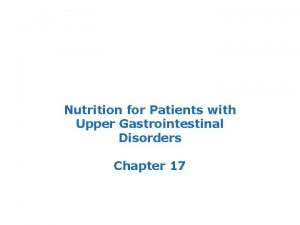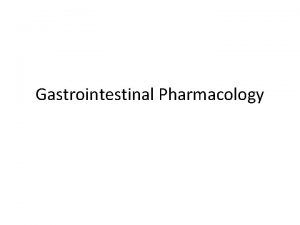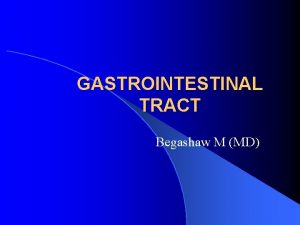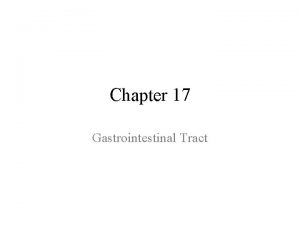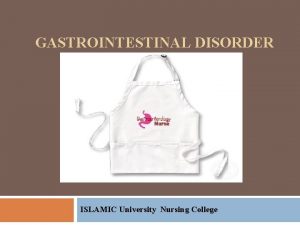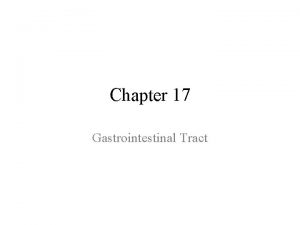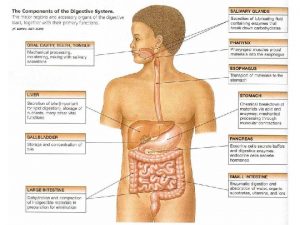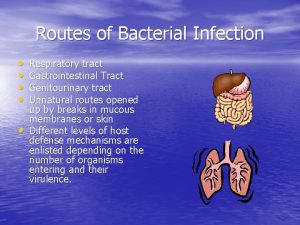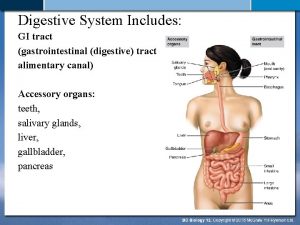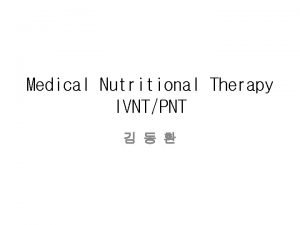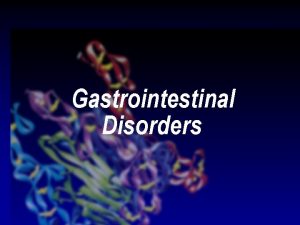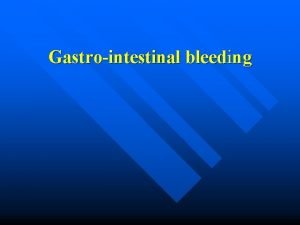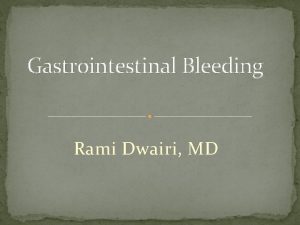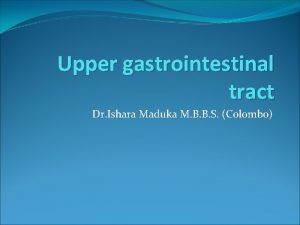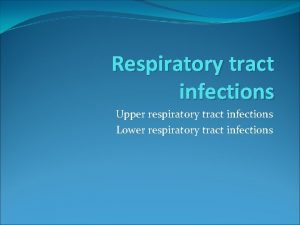Medical Nutrition Therapy for Upper Gastrointestinal Tract Disorders






































- Slides: 38

Medical Nutrition Therapy for Upper Gastrointestinal Tract Disorders 上消化道疾病 348

Digestive Disorders ¾ ¾ ¾ Common problem; more than 50 million outpatient visits per year Dietary habits and nutrition play key roles in prevention and treatment of diseases of the gastrointestinal tract (GIT) Medical nutrition therapy is necessary to prevent and treat malnutrition associated with the diseases of the GIT Elsevier items and derived items © 2012, 2008, 2007 by Saunders, an imprint of Elsevier Inc. 2

Assessment Parameters ¾ ¾ ¾ Screening: most important indicator is unintentional weight loss Diet history: changes in appetite, nausea, vomiting, diarrhea, chewing and swallowing problems, food intolerances, typical intake Laboratory parameters: vitamin B 12, folate, ferritin, 25 -hydroxy vitamin D Elsevier items and derived items © 2012, 2008, 2007 by Saunders, an imprint of Elsevier Inc. 3

Disorders of Esophagus Lower Esophageal Sphincter (LES)


Esophagitis (潰爛型GERD ):較嚴重食道發炎 n n n 服用抗發炎藥物(aspirin, NSAIDS) 、腐蝕性藥物 放射線 Etiology Acute:Ingestion of irritating agents, viral infection, intubation插管 Chronic:Reduced LES pressure, increased abdominal pressure, recurrent vomiting, delayed gastric emptying, hiatal hernia 緊衣服 高脂 肥胖 大量食物 硬皮症、smoking、diet、 SMC鬆弛劑、黃體激素(避 孕藥、月經晚期)

Medical Nutrition Therapy (p. 596) Objective: n 防止食道逆流 (LES) avoid large meals (少量多餐)、 dietary fat、 alcohol n 預防發炎黏膜疼痛刺激 avoid acid foods (酸果汁), spices n 減少侵蝕力、胃酸 avoid coffee, 吸煙、 fermented alcoholic beverages n 出血 補充Fe, B 12, protein

Behavioral Modification Avoid n Eating within 3 -4 hrs of retiring(休息) n Lying down after meals:提高床頭 4 -6 in n Tight-fitting garments:減肥 n Cigarette smoking:LES

Nutritional Care Guidelines for Patients with Reflux and Esophagitis n n n n n Avoid large, high-fat meals. Avoid eating at least 3 to 4 hours before retiring. Avoid smoking. Avoid alcoholic beverages. Avoid caffeine-containing foods and beverages. Stay upright and avoid vigorous activity soon after eating. Avoid tight-fitting clothing, especially after a meal. Consume a healthy, nutritionally complete diet with adequate fiber. Avoid acidic and highly spiced foods when inflammation exists. Lose weight if overweight.








Gastritis and Peptic Ulcer n n 原因:感染(幽門螺旋桿菌 H. pylori)、化學物 質(aspirin, NSAIDS, steroid, alcohol, tobacco)、 神經異常(壓力) 破壞黏膜、線體完整 (發炎) 消化性潰瘍(peptic ulcer) or atrophic gastritis (achlorhydria or loss of intrinsic factor) or cancer H. pylori:具運動性鞭毛之格蘭氏陽性菌,可 抗胃酸 - 分泌尿素酶(產氨促進鹼性化)


Medical Nutrition Therapy n n Lack of intrinsic factor(內在因子) and acid – decrease absorption of B 12, iron, Ca 若用劑量高的胃酸抑制藥或出血 anemia

Peptic Ulcer (p. 601) Etiology n H. Pylori infection 幽門螺旋桿菌 n Stress ulcer:嚴重燒傷、創傷、手術、腎衰竭、 放射線治療之併發症(出血、胃缺血) n Alcohol, Aspirin and other NSAIDs:刺激胃酸 分泌、危及黏膜完整 n Use of tobacco decrease HCO 3 - secretion & mucosal blood flow, increase inflammation

Pathophysiology n n n 發炎、潰爛發生在黏膜膜層至肌肉層 下降腸胃道防禦和修復系統 Symptom:abdominal pain or discomfort, anorexia, wt loss, nausea, vomiting, heartburn 出血、穿孔 Melena –黑便


Stress Ulcers ¾ ¾ Complication of severe burns, trauma, surgery, shock, radiation therapy, or renal failure Gastric ischemia, hypoperfusion, oxidative injury, reflux of bile acids or pancreatic enzymes, microbial colonization, and mucosal barrier changes are implicated Significant cause of morbidity in critically ill patients Use of antioxidant compounds show promise Elsevier items and derived items © 2012, 2008, 2007 by Saunders, an imprint of Elsevier Inc. 23

Factors That Affect Gastric Acidity Increase Gastric Acidity Cephalic Phase of Digestion Thought, taste, smell of food, and chewing and swallowing initiate vagal stimulation of the parietal cells in the fundic mucosa, resulting in secretion of gastric acid. Gastric Phase of Digestion Effect of food in the stomach: • Distension of the fundus stimulates the parietal cells to produce acid. • Increased alkalinity of antrum causes the release of gastrin, which stimulates gastric acid secretion. • Distension of the antrum causes release of gastrin. • Substances in certain foods and digestive products increase acidity (e. g. , coffee, both with or without caffeine; alcohol; Elsevier items and derived itemsacids © 2012, 2008, [products 2007 by Saunders, an of imprint of Elsevier Inc. digestion]). 24 polypeptides and amino protein

Factors That Affect Gastric Acidity Decrease Gastric Acidity Gastric Phase of Digestion Acidification of the antrum reduces gastrin release and thus gastric acid secretion. Food, especially protein, has an initial buffering effect. Intestinal Phase of Digestion Fat, acid, and protein in the small intestine stimulate release of one or more GI hormones that inhibit gastric acid secretion.

Medical management n n 少用 NSAIDs 用 antibiotics, sucralfate (胃乳) 制酸藥antacids、proton pump inhibitors or H 2 -receptor blockers 手術已少見,但嚴重需gastrectomy, vagotomies迷走神經切除術

Behavioral management n Avoid tobacco product:下降HCO 3 -分泌、 黏膜血流、增加發炎反應、感染併發症

Nutrition management (Bland diet) n n n Protein foods: temporarily buffer gastric secretion, but stimulate secretion of gastrin, acid and pepsin (milk is no longer considered) PH of food has little therapeutic important Decrease consumption of alcohol, spices, caffeine:增加胃酸分泌,胃壁發炎、改變消 化道permeability or motility, mucosa damage, but turmeric (薑黃)減少H. pylori黏附胃壁。

Nutrition management n n n Use of probiotics(益生菌):預防 H. pylori Increase intake of n-3 and n-6 fatty acid : Prostaglandin (PGE 3減少PGE 2) (抗發炎、增加 免疫力、保護GI mucosa) 高品質飲食(adequate nutrient, fruit, vegetable and fiber intake)、避免營養素缺乏(影響消化道 細胞修護)或難消化食物、少量多餐(減少胃酸 反流、增加胃部血液循環) 增加免疫力、 防止H. pylori




Medical Nutrition Therapy after gastric surgery n n n Anorexia:TPN or liquid diet 消化道功能恢復 (1) ice water (2) liquid diet:全、半流質飲食 (3) soft diet (low fat, species, frequent diet) 手術後亦導致吸收不良(dumping Syndrome)


Dumping syndrome n n Complication:loss wt, malabsorption, steatorrhea anemia, osteoporosis, vitamin & mineral deficiency (Fe & B 12) 藥物治療:somatostatin analogs (延緩胃 空) acarbose (抑制消化醣類酵素 acarbase)

恢複營養狀 態、生活品 質 Diet: Fat 35 -45%, (MCT oil) Protein: 20% Ca & Vitamin D

膳療實驗 n n n 第 1, 2组 :Soft diet (exp. 4) 2000 kcal 3 :Semiliquid diet ( exp. 5) p. 15 (2000 kcal) 4 :Full liquid (exp. 6)(2000 kcal) p. 18 5 :Clear liquid diet (exp. 8) p. 25範例 6 :Bland diet (exp. 11) p. 35 第四題 7, 8 :Diet for Dumping Syndrome (Exp. 16) : protein 20%, Fat 45%, CHO 35% , 2000 kcal

The end
 Gastrointestinal tract
Gastrointestinal tract Chemotrypsinogen
Chemotrypsinogen Composition of stomach
Composition of stomach Alimentary canal diagram
Alimentary canal diagram Pneumatic reduction of intussusception
Pneumatic reduction of intussusception Pathophysiology of intestinal obstruction
Pathophysiology of intestinal obstruction Medical nutrition therapy for stroke
Medical nutrition therapy for stroke Medical nutrition therapy for hypertension
Medical nutrition therapy for hypertension Small bowel obstruction nutrition management
Small bowel obstruction nutrition management Gastrointestinal medical terminology breakdown
Gastrointestinal medical terminology breakdown Extrapyramidal tract function
Extrapyramidal tract function Dorsal reticulospinal tract
Dorsal reticulospinal tract Respiratory physiology
Respiratory physiology Classification of upper respiratory tract infection
Classification of upper respiratory tract infection Upper and lower respiratory system
Upper and lower respiratory system Anatomy of the upper respiratory tract
Anatomy of the upper respiratory tract Steeple sign
Steeple sign Upper rti
Upper rti What is the major function of the respiratory system
What is the major function of the respiratory system Chassard lapine
Chassard lapine Structure of the upper respiratory system
Structure of the upper respiratory system Uses of vertical suspension
Uses of vertical suspension Nutrition fundamentals of nursing
Nutrition fundamentals of nursing Embriologia del sistema gastrointestinal
Embriologia del sistema gastrointestinal Emt chapter 18 gastrointestinal and urologic emergencies
Emt chapter 18 gastrointestinal and urologic emergencies Chapter 15 the gastrointestinal system
Chapter 15 the gastrointestinal system Gastrointestinal hormones
Gastrointestinal hormones Malrotasi traktus gastrointestinal
Malrotasi traktus gastrointestinal Esganadura
Esganadura Verner morrison sendromu
Verner morrison sendromu Nutrition focused physical assessment
Nutrition focused physical assessment Foregut midgut hindgut
Foregut midgut hindgut Motilidad gastrointestinal
Motilidad gastrointestinal Upper gi bleeding management
Upper gi bleeding management Divisao anatomica do estomago
Divisao anatomica do estomago Doença gastrointestinal
Doença gastrointestinal Functional constipation vs hirschsprung
Functional constipation vs hirschsprung Oral yol neresi
Oral yol neresi Gastrointestinal structure
Gastrointestinal structure

